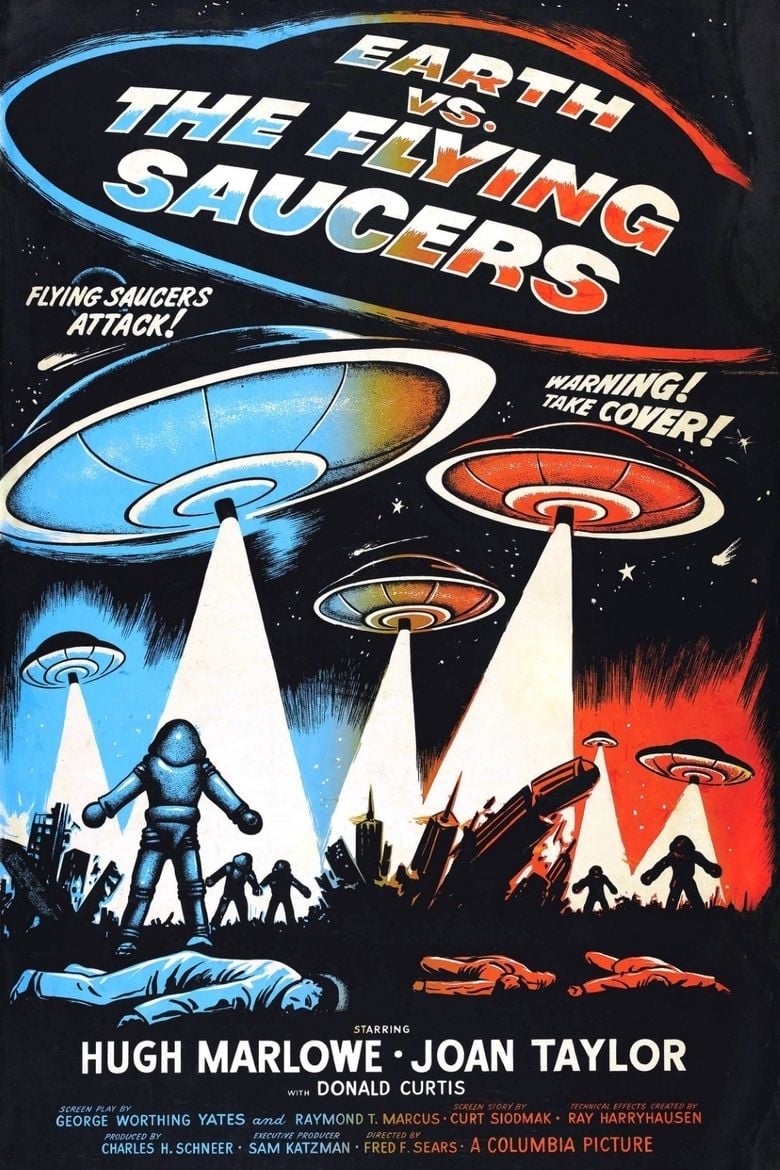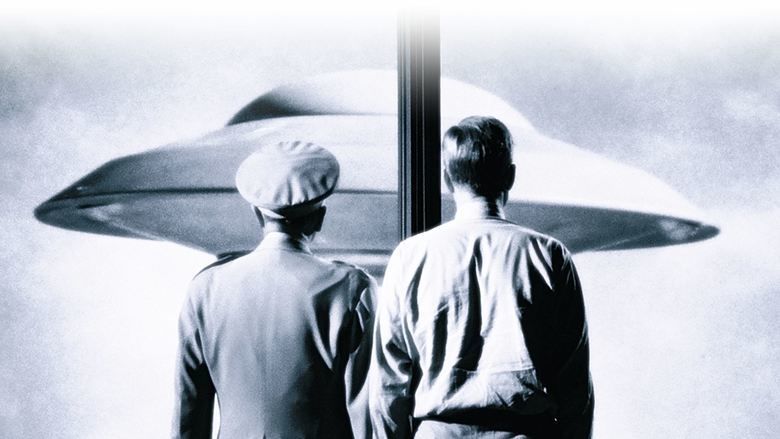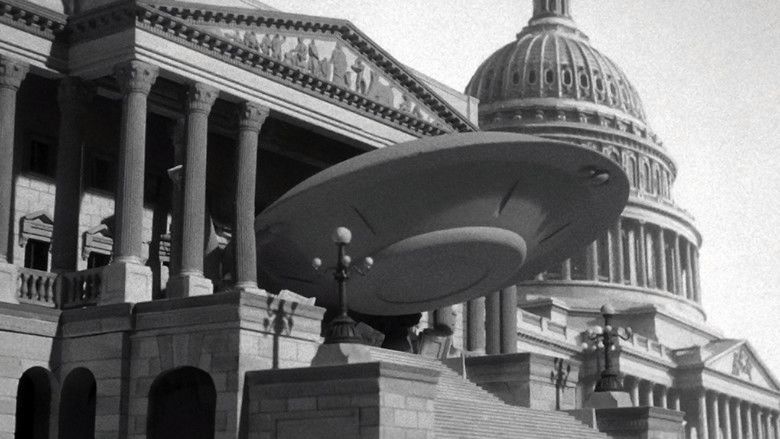Earth vs the Flying Saucers
6.8 /10 1 Votes6.8
71% Rotten Tomatoes Genre Fantasy, Horror, Sci-Fi Duration Country United States | 6.4/10 IMDb Initial DVD release September 17, 2002 Language English | |||||||||||||||||||||||||||||||||
 | ||||||||||||||||||||||||||||||||||
Release date July 1, 1956 (1956-07-01) Music director Mischa Bakaleinikoff, Mischa Bakaleinikov Cast (Dr. Russell A. Marvin), (Carol Marvin), Donald Curtis (Maj. Huglin, Liason Officer), (Brig. Gen. John Hanley), (Prof. Kanter), (Vice Adm. Enright)Similar movies Close Encounters of the Third Kind , The Day the Earth Stood Still , E.T. the Extra-Terrestrial , Independence Day , Flight of the Navigator , Lilo & Stitch Tagline The terrifying truth about flying saucers! | ||||||||||||||||||||||||||||||||||
Earth vs. the Flying Saucers (a.k.a. Invasion of the Flying Saucers and Flying Saucers from Outer Space) is a 1956 American black-and-white science fiction film from Columbia Pictures, produced by Charles H. Schneer, directed by Fred F. Sears, that stars Hugh Marlowe and Joan Taylor. Earth vs. the Flying Saucers was released on a double bill with The Werewolf
Contents

The film's storyline was suggested by the bestselling, non-fiction book Flying Saucers from Outer Space by Maj. Donald Keyhoe.

The film's stop-motion animation special effects were created by Ray Harryhausen.
Earth vs the flying saucers trailer
Plot
Scientist Dr. Russell Marvin (Hugh Marlowe) and his new bride Carol (Joan Taylor) are driving to work when a flying saucer appears overhead. Without proof of the encounter, other than a tape recording of the ship's sound, Dr. Marvin is hesitant to notify his superiors. He is in charge of Project Skyhook, an American space program that has already launched 10 research satellites into orbit. General Hanley (Morris Ankrum), Carol's father, informs Marvin that many of the satellites have since fallen back to Earth. Marvin admits that he has lost contact with all of them and privately suspects alien involvement. The Marvins then witness the 11th falling from the sky shortly after launch.
When a saucer lands at Skyhook the next day, a group of aliens in metallic suits exit, and the infantry guards open fire, resulting in the death of one alien, while others and the saucer are protected by a force field. The aliens proceed to kill everyone at the facility but the Marvins; General Hanley is captured and taken away in the saucer. Too late, Russell discovers and decodes a message on his tape recorder: the aliens wanted to meet with Dr. Marvin and landed in peace at Skyhook for that purpose, but instead, they were met with violence. Impatient to conduct that meeting after everything has gone sideways, Marvin contacts the aliens and steals away to meet them, followed closely by Carol and Major Huglin (Donald Curtis). They and a pursuing motorcycle patrol officer are taken aboard a saucer, where the aliens extract knowledge directly from the General's brain. The aliens explain they are last of their species, having fled from their destroyed solar system. They have shot down all the launched satellites, fearing them as weapons. As proof of their power, the aliens give Dr. Marvin the coordinates of a naval destroyer that opened fire on them, and which they have since destroyed. Horrified by the cold, unempathic nature of the aliens, Carol begins to break down, and the patrol officer, despite an attempt by Marvin to stop him, pulls his revolver and fires on the aliens; he is subjected to the same mind control process as General Hanley. The alien explains that they will eventually return General Hanley and the patrol officer. As the interaction continues, Carol becomes increasingly irrational, while Marvin tries to remain calm. Major Huglin and the Marvins are released with the message that the aliens want to meet with the world's leaders in 56 days in Washington, D.C. to negotiate an occupation of Earth.
Dr. Marvin's later observations discover that the aliens' protective suits are made of solidified electricity, and grant them advanced auditory perception. From other observations, Marvin develops a counter-weapon against their flying saucers, which he later successfully tests against a single saucer. As they escape, the aliens jettison Gen. Hanley and the patrol officer, both falling to their deaths. Groups of alien saucers then attack Washington, Paris, London, and Moscow, but are destroyed by Dr. Marvin's sonic weapon. The defenders also discover that the aliens can be easily killed by simple small arms gunfire once they are outside the force fields of their saucers.
With the alien threat eliminated, Dr. Marvin and Carol quietly celebrate the victory by going back to their favorite beach, resuming their lives as newlyweds.
Visual effects
Special effects expert Ray Harryhausen animated the film's flying saucers using stop-motion animation. Harryhausen also animated the falling masonry when saucers crash into various government buildings and monuments in order to make the action appear realistic. Some figure animation was used to show the aliens emerging from the saucers. A considerable amount of stock footage was also used, notably scenes during the invasion that showed batteries of U. S. 90 mm M3 guns and an early missile launch. Stock footage of the destruction of the warship HMS Barham during World War II was used for the U. S. Navy destroyer that is sunk by a flying saucer. Satellite launch depictions made use of stock film images from a Viking rocket launch and a failure of a German V-2 rocket. The aircraft that are shown crashing after being hit by an alien ray is actual stock footage shot of a real military aircraft accident that happened during World War II, on July 23, 1944. [1]
The voice of the aliens was produced from a recording made by Paul Frees (uncredited) reading their lines and then hand-jiggling the speed control of an analog reel-to-reel tape recorder, so that it continually wavered from a slow bass voice to one that is high and fast.
During a question-and-answer period at a tribute to Ray Harryhausen and a screening of Jason and the Argonauts held in Sydney, Australia, Harryhausen said he sought advice from noted 1950s UFO "contactee" George Adamski on the depiction of the flying saucers used in the film. He also noted that Adamski appeared to have grown increasingly paranoid by that time. The film's iconic flying saucer design (a static central cabin with an outer rotating ring with slotted vanes) matches descriptions given to Maj. Donald Keyhoe of flying disc sightings in his best-selling flying saucer book.
Reception
From contemporary reviews, Earth vs. the Flying Saucers was reviewed in Variety, where the reviewer noted that the special effects were the real stars of the film. "This exploitation programmer does a satisfactory job of entertaining in the science-fiction class. The technical effects created by Ray Harryhausen come off excellently in the Charles H. Schneer production, adding the required out-of-this-world visual touch to the screenplay, taken from a screen story by Curt Siodmak, suggested by Major Donald E. Keyhoe’s Flying Saucers from Outer Space." The Monthly Film Bulletin gave the film a negative review, stating that the "semi-documentary technique" was "pretentious" and the film's use of stock footage, "crude model-work" and most of the best-known science-fiction clichés made the film "a long-winded and rather bleak invasion from outer space."
Earth vs. the Flying Saucers has reached an iconic status in that many films in the "flying saucer" subgenre that followed, imitated and incorporated many of the elements established by Ray Harryhausen. In an article for The New York Times film reviewer Hal Erickson noted that, "Anyone who's seen the 1996 science-fiction lampoon Mars Attacks! may have trouble watching Earth vs. the Flying Saucers with a straight face." The later campy film could be seen as an homage to the era, especially to the contributions made by Earth vs. the Flying Saucers.
Legacy
Several films have recycled stock footage from the film, including The Giant Claw and The 27th Day (1957), an episode of the Twilight Zone (1985) and the short Flying Saucer Daffy (1958).
References
Earth vs. the Flying Saucers WikipediaEarth vs. the Flying Saucers IMDbEarth vs. the Flying Saucers Rotten TomatoesEarth vs the Flying Saucers themoviedb.org
